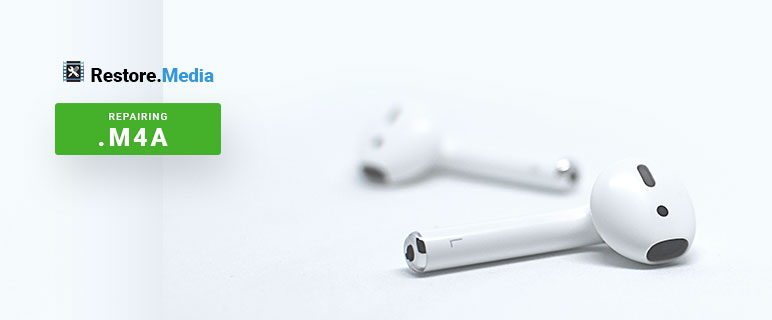
In this article, we will show you how to repair M4A files online without downloading or installing any third-party tools.
In particular, the guide will be helpful if you need to:
- Repair M4A audio files recorded on any device or application
- Fix a corrupted voice memo on iPhone
So, let's get started...
8 Easy steps to repair M4A files online
Here, at Restore.Media, we have created an online M4A repair tool that works right from your iPhone, Android, Mac, or Windows device.
There is no need to download or install anything – M4A files can be fixed online from a web browser.
This is how it works:
Step 1
First, sign up for a free account at Restore.Media.
Please note that you can repair M4A files using Restore.Media and get audio preview for free. But there is a small fee to download the repaired file in its original quality.
Step 2
After submitting the registration form, you will receive a confirmation email. Click the link in the email to start repairing your audio file.
If you can't find the confirmation email, check your spam folder. It may be that the letter got there by mistake.
Step 3
After you click the link in the email, a welcome page will open.
Click Get started to continue:
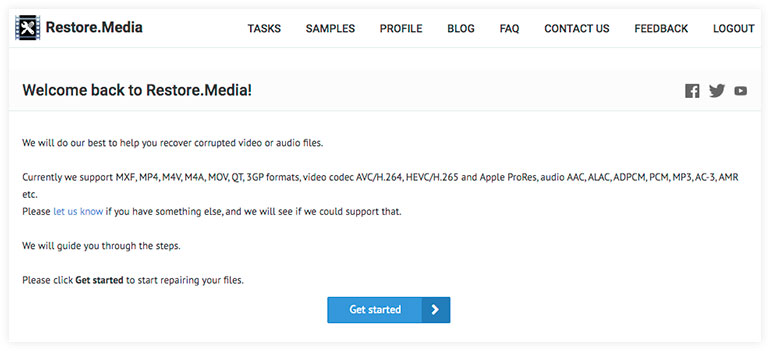
Step 4
On this step, select the device you used to record the corrupted M4A file.
Restore.Media has several different recovery algorithms tailored to specific device models. Make sure to select the correct device from the list to increase the likelihood of a successful recovery.
If you cannot find your device in the list, just select Generic M4A file (audio only) and then enter your device model in the text box manually.
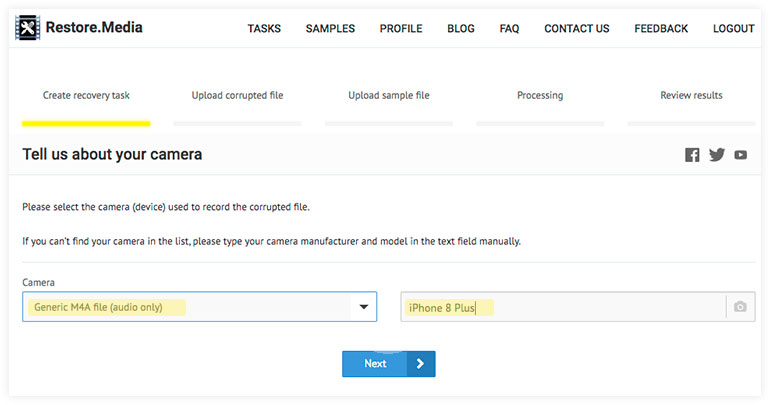
If you don't know which device was used to record the file, select Generic M4A file (audio only) and leave the text box blank.
Step 5
Now create a recovery task. To do this, give the task any name that is easy to remember and click Next:
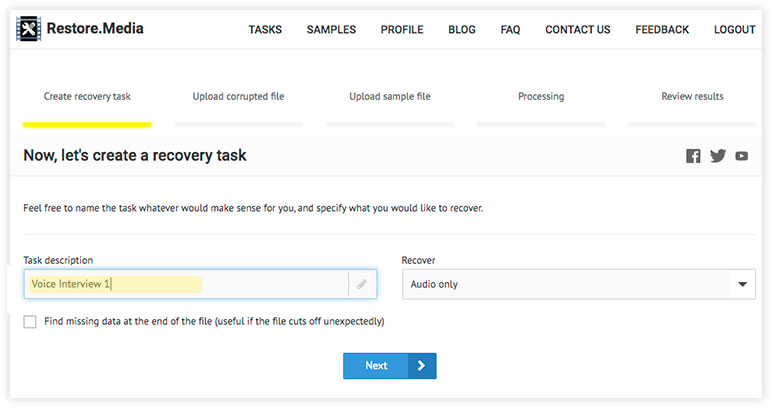
Step 6
Upload your corrupted M4A file:
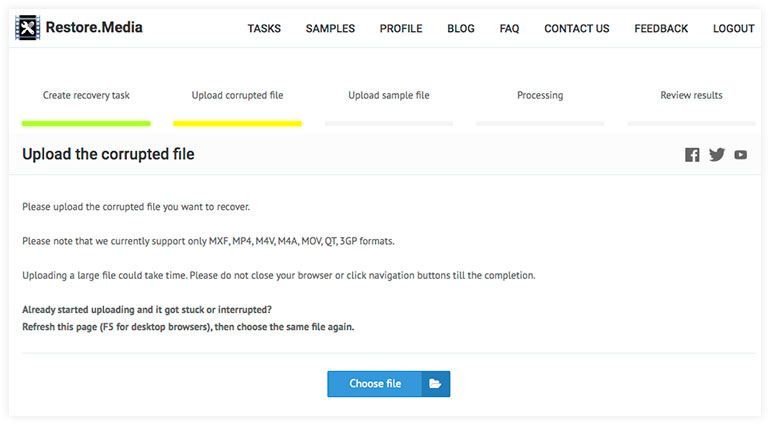
Step 7
At this point, Restore.Media will either immediately start repairing your file, or it will ask you to upload a sample file.
If you are asked to upload a sample file, this usually means that the tool needs to extract the metadata from a valid playable M4A file and insert it into the corrupted one.
As a sample file, you can take any working (not damaged) M4A audio file recorded on the same device and with the same settings (e.g. mono / stereo, the same bit rate, etc.) as the damaged file.
If you don’t have a sample file, you can either record it (a 1-minute audio file is sufficient), or contact us and our engineers will try to find a sample file for you.
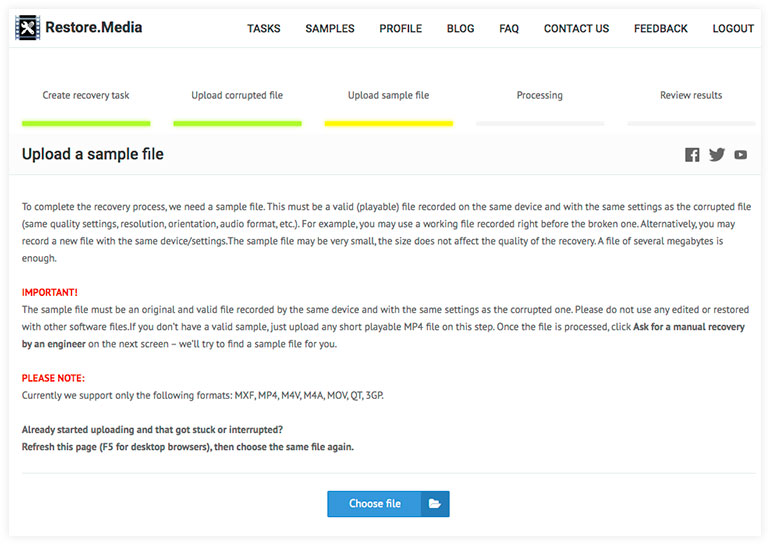
Step 8
Once everything is set up, Restore.Media will start repairing the corrupted M4A file automatically. If the file was successfully repaired, you should see the following screen:
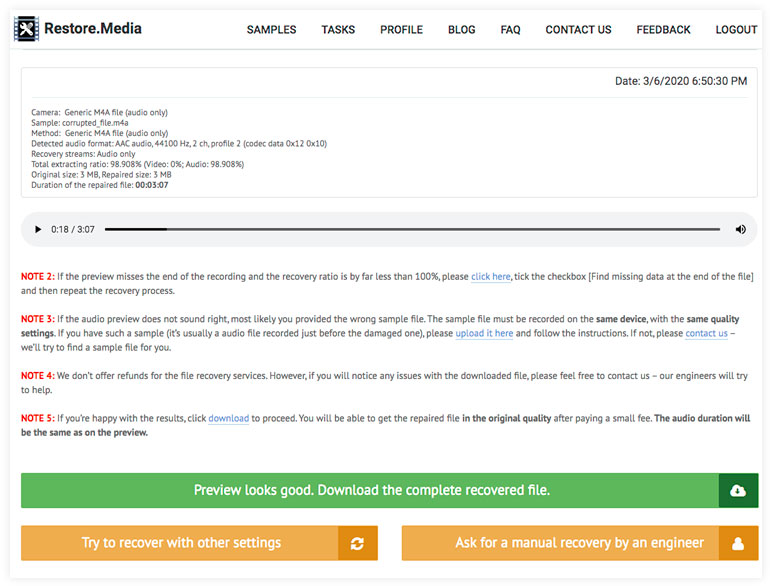
Here you can play a preview of the recovered file.
Please note that the audio preview is of low quality, just so you can check if the file has actually been fixed. But you can download the repaired M4A file in original quality for a small fee.
Before downloading the file, we recommend that you check the entire preview, including the last few seconds.
If you're happy with the results, click the big green button – Preview looks good. Download the complete recovered file.
If there is something wrong with the sound in the preview, or the file has not been repaired, read the notes under the player and follow the instructions.
You can also request manual recovery of the M4A file by one of our engineers. To do this, click on the button – Ask for manual recovery by an engineer.
Fixing a corrupted voice memo on iPhone
There is a known issue when trying to fix corrupted voice memos on iPhone.
After repairing the file, it may appear that there is either no audio data, or some of the recording is missing at the end of the file.
This is due to the way the Voice Memo app works.
When recording sound, the application writes it to its cache and then saves it in the permanent memory of the iPhone. If the recording process is interrupted unexpectedly, the Voice Memo application may not save the data from its cache to the iPhone memory, and the data will be permanently lost.
Unfortunately, it is not possible to recover audio data from the application cache as it acts as temporary memory.
Oddly enough, a corrupted voice memo on iPhone can indicate its expected full length, even if it does not actually contain the portion of audio data that was lost in the application cache.
If some of the recorded data is missing in the repaired M4A file, please pay attention to the total extracting ratio as shown below.

When this value is close to 100%, it means that all the actual audio data has been recovered, nothing is left, no matter what the Voice Memo app shows.
Unfortunately, we will not be able to recover more data than there is in the audio preview.
Why can't a corrupted M4A file be played?
We often see people come with corrupted audio files recorded with the Voice Memo app on their iPhone devices. But damaged M4A files are a fairly common problem on all other platforms, including Android, as well.
M4A is a media container similar to MP4, but only with audio tracks (no video).
Each M4A file contains an audio track and metadata.
Metadata is information about the recording settings (length, format, compression method, etc.).
Now, here's how the problem usually arises:
When you record a voice memo, interview or any sound on your smartphone, an incoming call can interrupt the recording process. In this case, the recording application may not save the audio file correctly. As a result, the file is damaged and cannot be played.
A similar issue can occur when recording M4A audio files on any other device such as laptop, desktop, camera, or tablet. The recording process may be interrupted by a device failure or unexpected shutdown due to loss of power.
Usually, if the audio recording was stopped correctly, metadata is saved at the end of the M4A file.
But in the case where the recording was interrupted, the recorder or application cannot save the metadata in the file correctly.
You will not be able to play such a corrupted M4A file because it lacks metadata and indexes.
In the worst case, part of the audio track at the end of the file can also be lost due to the way Voice Memo (or similar applications) record data – see this chapter for more details.
When you try to play a corrupted M4A file, you will either see an error, or the player will look like it is playing the file, but there will be no sound and the timeline will not move.
The good news is that if you have a similar problem with a corrupted M4A file, there is a good chance to fix it – just follow the instructions in this chapter.
___________
We hope you will repair M4A files without any problems with this guide. If you still have any questions or need help, please feel free to contact us.
Happy recovering!